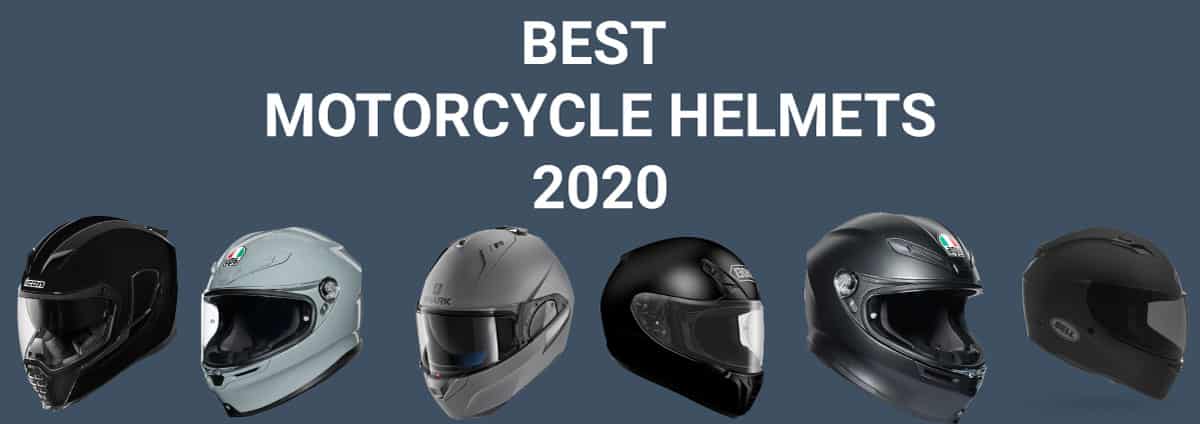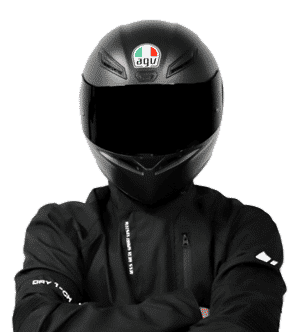What are the Best Motorcycle Helmets to Buy for a Beginner in 2020?
- Bell Qualifier Helmet
- AGV K6
- Shoei RF 1200
- You get what you pay for.
- What Is Your Budget?
- What are the different types of helmets?
- How do I know my head shape?
- How do I know my motorcycle helmet size?
- How do I choose a motorcycle helmet?
- What should I look for in a helmet?
- How tight should my helmet fit?
- What is the average cost of a motorcycle helmet?
- How long should you keep a motorcycle helmet?
- Should I buy a used helmet?
- Best Value
- Best Choice
- Premium Pick
- Shark EVO One 2 Helmet
- Icon Airflite
- Conclusion
You get what you pay for.
The thrill of riding a motorcycle needs to be complemented by the comfort of feeling safe. The different shapes, colors, sizes, features, and prices of motorcycle helmets should all be compared before you choose one. Just remember: you definitely need one, no matter how experienced you are or on what kind of terrain you plan on riding.
More expensive helmets feature better airflow vents, moisture-wicking technology, aerodynamic designs, and incredible safety and comfort features. You can get a lot of these things on a budget as well, but you’ll have to pick and choose based on your needs.
For experienced and amateur riders alike, here is your guide to understanding what to look for in a motorcycle helmet, how to choose the right one for your head, and which will best suit your specific needs as a rider.
What Is Your Budget?
Certainly, your budget will be at the forefront of your mind when you’re shopping for helmets. Just make sure you don’t cheap out: a helmet priced significantly below the average is probably made of cheap materials. Keep in mind that this is the only thing standing between you and the pavement if something goes wrong.
There’s also the fact that cheapness may come with a lack of longevity, meaning that your bargain helmet may turn into an obligation to purchase another one sooner than you’d expected, which won’t save you any money in the long run.
Remember that it’s your head on the line. Since better models come with better resistance to the natural wear and tear of riding, more safety features, and enhanced comfort on long rides, it’s important not to let budget get in the way of finding the features that any good helmet uses to enhance their rider’s experience and keep them safe.
What are the different types of helmets?
There are six main types of motorcycle helmet and each comes with its own uses. Since your helmet is probably your most important bit of safety gear, knowing which type will best suit your needs is a pretty necessary first step to buying the right one.
The first two types are similar and they’re called full face and modular. These helmets cover your whole head and look like standard riding helmets. The only difference is that modular helmets have a visor that you can flip open and shut.
They have more functionality than a full face helmet but are a tiny bit less secure and weigh a bit more too because of the hinge mechanism and the extra stuff inside.
Off-road and dual-sport helmets are ideal for someone who knows they’ll be riding in mud or for sports and races. These helmets give you more protection for even less weight than the full face models, a larger visor for better visibility in wooded terrain (dual-sport only), and a more open mask for increased airflow to the neck and chin.
Just remember that dual-sport helmets don’t come with visors so you’ll need to add the cost of goggles to your overall budget for buying the right headgear for your needs.
Lastly, as an experienced rider or a rider in a less congested traffic area who knows that they won’t be doing any off-road sports, a smaller helmet could do the trick. Half helmets and open-faced helmets are possible alternatives that offer some limited protection without dealing with any of the bells and whistles of the more sports-oriented models.
Half helmets don’t even have a visor, so prepare for that (open face models do).
How do I know my head shape?
Did you know that different heads have different shapes? There are four main types of heads and which you are (and to what degree) will determine the size and type of helmet you should wear.
The first type is oval, meaning that your head is longer and narrower than average. After that, the average head shape appears sort of between the others, still shaped like an oval but in a less pronounced way. Finally, you could have a round head, which is uniformly long and wide.
How can you figure out which type of head you have? The easiest way is to look in a mirror and point your head down. The shape of the top of your head will tell you which category you fit in.
How do I know my motorcycle helmet size?
After you know the shape of your head, obviously you’re going to want to know its size to properly fit your helmet to your head. This is even more important in the internet age when many of us will have to buy our helmets off the internet without being able to try them on first (however, most riders recommend trying them on in a store first so you can wear them for a while and figure out if there are any areas of irritation with prolonged use).
Find a measuring tape and wrap it around your head. Where do you wrap it, exactly? It’s important to measure at the point where your head is at its biggest, which is usually around where your eyebrows are.
Once you know that number, you can easily look up a sizing chart for the brand of helmet you’re looking for, for each product specifically.
How do I choose a motorcycle helmet?
You need to ask yourself a few questions before you choose the make and model of your motorcycle helmet.
The first questions are quantitative: you need to know your head shape and size to know exactly how you fit into your prospective product’s sizing chart. See above for how to do this.
Next, you need to know your budget. You don’t want to go too cheap (this is your safety we’re talking about, after all). However, we all have our limits.
Finally, you need to know your needs as a rider so you can match them to the type of helmet that’s right for you.
Ask yourself where and how often you think you’ll be riding your motorcycle. Those who expect to be doing a lot of sports-related or off-road riding, for instance, are going to need more than a half helmet. Off-road and dual-sports options have special ventilation and visibility features for people driving in wooded areas.
If you’re a casual rider, a basic full face helmet may do the trick. If you feel especially advanced, you may be able to get away with a scarcer model. Whatever your needs, you need to research the features and benefits of each type of helmet in order to best match it to your experience level and riding location.
What should I look for in a helmet?
Once you’ve matched your helmet to your needs in terms of its price, size, and general type, you want to look at features of specific models to pick the one that’s right for you.
Look at how it’s ventilated, how the chin is structured, how tight it is around your head, and whether parts can be removed for safety or comfort. Look at the visor and consider the kind of weather and terrain you’ll be wearing it in.
Make sure it has multiple exhaust ports for breathing and that it meets the All World Standard for testing and safety specifications.
How tight should my helmet fit?
A properly fitting motorcycle helmet should not be too tight or too loose. It should be just a little difficult to put on so that it grips your head snugly, though obviously not so tight that it’s uncomfortable.
The accepted test to determine if your helmet is snug enough to protect your head is to pull on the bottom of the helmet so that your head bobs up and down. If the helmet slides around on your head, it’s too loose. If your whole head moves with it, it’s just right.
What is the average cost of a motorcycle helmet?
Obviously, you could pay a lot more or a lot less for a motorcycle helmet depending on the features that you want. The absolute maximum cost could be over $1000. However, generally, a good helmet should only set you back between $150 and $200.
How long should you keep a motorcycle helmet?
Most riders recommend not waiting longer than 5 years to replace a helmet. It’s your most important piece of safety gear, after all. You don’t want anything to go wrong with it at the wrong time.
Should I buy a used helmet?
You may think that buying a used helmet is a great way to save money. While you may be able to get it cheap, this isn’t a good idea.
The main reason is that you’ll be tempted to compromise on certain features that you need like the quality of the visor or the ventilation of the chin section. These things can become important on the road. Lacking the features you need can turn a peaceful ride into a dangerous situation.
Even more importantly, you’re not going to find the exact right size and shape for your head. You really need to go to a place where you can get one fitted and try them all on. Before you decide to buy it, you should also wear it in the store for 30 minutes at least. That way, you can make sure that there’s no unwanted looseness or chaffing.
So, What Are the Best Helmets of 2020?
Best Value
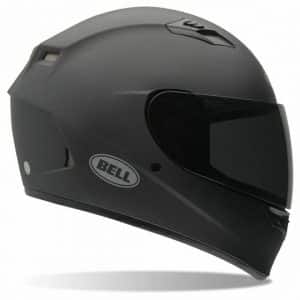
The Bell Qualifier Helmet sits comfortably below the average price of a helmet of its quality. It doesn’t come with a ton of bells and whistles, but it’s built for comfort, features insane stability due to its refined shape, and comes with a five-year warranty.
Features:
- Lightweight polycarbonate Shell
- 3 shell sizes
- SM: XS and SM Helmets
- MD: MD and LG Helmets
- LG: XL to 3XL Helmets
- Removable washable, and antibacterial interior
- Aerodynamic design for exceptional stability
- Adjustable ventilation system for cooling and comfort
- Padded wind collar to drastically reduce wind and road noise
- Contoured cheek pads for excellent fit and comfort
- Integrated speaker pockets for audio speakers
- ClickRelease for a fast, easy and tool-free shield change
- NutraFog II superior anti-fog, anti-scratch and UV protected shield
- Padded chin strap with D-ring closure
- DOT approved
- Industry-leading five-year warranty
Its stylish, simple look is a big benefit to those who want pure function out of their helmet’s performance. Noise reduction and padding provide a stable, consistent, and pleasurable riding experience, which is why it’s our pick for the best value of 2020.
Best Choice
Aggressive, versatile, and enviably functional, the AGV K6 Helmet features a ton of safety and comfort features.
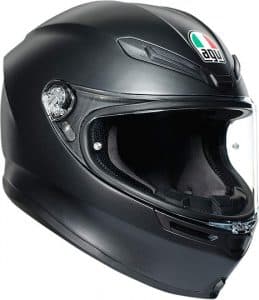
Features:
- Carbon-aramid shell
- 4 shell sizes: XS-SM, MS, ML-LG, XL-2XL
- 5 density EPS in 4 sizes
- Collarbone safe profile
- 5 adjustable front vents
- 1 wide rear vent
- Shell shaped designed to reduce turbulence and optimized for all riding positions
- Ritmo and Shalimar fabric cheek pads
- Shalimar fabric head liner
- Abrasion and water resistance neck roll for extra durability
- 2Dry moisture wicking system
- Eyeglasses friendly fit
- Removable breath guard included
- K6 helmet specific 4mm thick, anti-scratch Pinlock-ready face shield
- Pinlock lens insert included
- Innovative shield pivot reduces size and weight
- Double-D chinstrap
- DOT and ECE approved
It has one of the best cooling system and moisture-wicking lining of any helmet we surveyed in its price category and tons of options. No matter the riding conditions, terrain, or experience level of the rider, the AGV K6 is a versatile and completely safe choice.
Premium Pick
Now we’re talking about helmets that are at the top of the line. The Shoei RF-1200 Helmet is not a budget pick. This helmet, which ranges in price from $500 to almost $1000, comes in three main model types and is packed with features.
Boasting superior ventilation technology, this helmet is light and superbly comfortable. Its aerodynamic shape is designed to reduce wind noise and prevent buffeting. You won’t believe how light this thing is with the features that it boasts.
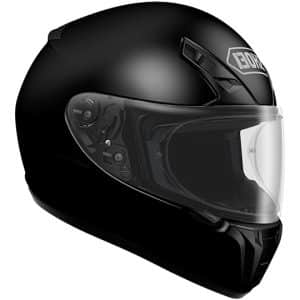
Features:
- Four shell sizes
- Dual density EPS liner
- Superior ventilation
- 3D Max-Dry System II Liner
- E.Q.R.S. (Emergency Quick-Release System) CWR-1 Shield System
- Neatly secure chin strap
- Includes Pinlock pins and lens insert
- Includes breath guard and chin curtain
- Snell M2015 and DOT Certified
The comfort and temperature control is second to none, with three-position vent rams affording more breathability and air-flow than any helmet in its class. The Pinlock face shield technology helps to keep air circulating while keeping the rain and the wind out. You’re paying for it, so it shouldn’t surprise you to know that even the shield comes with a five-option dial to tune the adjustments on your front plate.
Featuring increasingly tighter and more aerodynamic models as you go up in price, the Shoei is our premium pick for its functionality and abundance of luxury features.
Honorable Mentions
Shark EVO One 2 Helmet
Features:
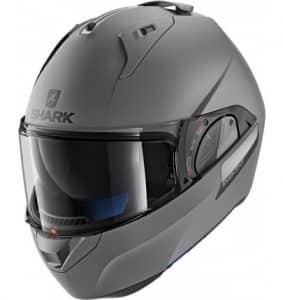
- Injected thermoplastic resin shell
- 2 shell sizes (XS-MD, LG-XL)
- Improved kinematic, quick-release, anti-scratch face shield
- Inner anti-scratch sun shield
- New chin guard locking/unlocking system
- Auto up/Auto down system allows the face shield to automatically lift when raising or lowering the chin guard
- Reinforced magnetic fastening of the chin curtain
- Compact aerodynamic profile
- Reduction in airborne noise
- New side plate design
- Double D-ring chin buckle
- Integrated chin curtain
- Eyeglasses friendly
- Max Vision Pinlock insert lens included
- DOT and ECE certified
Icon Airflite

Features:
- Injection molded polycarbonate shell for strength
- Multiple oversized intake and exhaust ports
- Fog-free inner sun shield
- Quick-change fog-free face shield
- Removable side plates
- Molded breath deflector
- Chin curtain
- Removable Hydradry moisture wicking liner
- Recessed twin channel supervent cooling system
- All world standard, meets or exceeds the following: DOT FMVSS 218 (US), ECE 22-05 (EUROPE), SAI AS1698 (AUSTRALIA) and SG (JAPAN) safety and testing standards. Does not ship with SAI OR SG Certification stickers unless purchased from an authorized dealer in that country
Conclusion
Making the choice of which helmet to buy can be a daunting one. With so many different features and options, it can be confusing. Hopefully this article will help you during your purchasing decision in 2020 for which helmet you decide to pick up!
